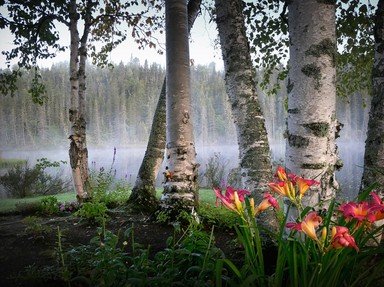Quiz Answer Key and Fun Facts
1. Once known as the world's loneliest tree, the Arbre du Ténéré was a 10-foot acacia tree that stood in the middle of the Sahara Desert in northern Nigeria. Located 250 miles away from the nearest tree, it was an important landmark, marking the site of a well 40 meters deep. This once monumental tree no longer stands. What brought about its demise in 1973?
2. In the early 1800s, out of love for a great white oak tree on his property, William H. Jackson deeded to the tree ownership of itself and the land surrounding it. The deed is purported to read, in part, "... for and in consideration of the great affection which he bears said tree, and his great desire to see it protected, has conveyed, and by these presents does convey unto the said oak tree, entire possession of itself and of all land within eight feet of it on all sides." Where does The Tree that Owns Itself plant its roots?
3. According to legend, the "father of medicine" imparted his medical wisdom to pupils under an oriental plane tree, located in the Platía Platanou (or "Square of the Platane") in Kos, Greece. The current tree is about 500 years old and is generally accepted to be the descendent of the original tree, which is believed to have lived for 2,400 years. This tree is named in honor of the teacher who spread knowledge beneath its branches, and is known as (the):
4. Carbon dating has shown the Sunland Baobab to be anything from 1,000 to 1,700 years old. In 1993, the hollows of its twin trunks were turned into a pub and a wine cellar, and the tree has become a popular tourist attraction. In what country is the Sunland Baobab located?
5. It should come as no surprise to anyone that the world's tallest species of trees is the Sequoia sempervirens, commonly known as the giant redwood, California redwood or coast redwood. The tallest measured Sequoia standing today is known as Hyperion, a coast redwood which is estimated to be between 700 to 800 years old. Topping out at an astonishing 379.3 feet, researchers have stated that one thing has prevented Hyperion from reaching 380 feet. What is stunting Hyperion's growth?
6. Pando, or The Trembling Giant, is a grand expanse of quaking aspen trees that spreads over more than 100 acres. Each of the 47,000 tree trunks in the area emanates from a single organism, and shares a giant underground root system. It is estimated that Pando weighs 6,615 tons, making it the heaviest living organism on the planet. Where is this quaking marvel located?
7. El Árbol del Tule is a Montezuma cypress tree on the grounds of a church in the Mexican state of Oaxaca. While most trees boast a significant height-to-girth ratio, El Árbol del Tule stands only 116 feet high but measures more than 119 feet around. Folklore states that the tree was planted 1,400 years ago by a priest of the Aztec wind god. In which god's name was this chubby tree planted?
8. One of the oldest and rarest trees on Earth, and thought to be long-extinct, the Wollemi pine was "discovered" in 1994 by an avid naturalist. The Wollemi pine, which is not a true pine, is a member of the 200 million-year-old Araucariaceae family. The oldest known Wollemi pine fossil dates back 90 million years. Today, there are less than 100 mature trees in the wild. Where was this pre-historic plant found alive and well?
9. At 13,000 years old, the Jurupa Hills oak tree in Southern California is the world's oldest known living organism. Scientists have noted that this scrappy tree has survived despite being located in an unnatural habitat. A member of the Palmer oak family, this tree prefers much higher elevations, with a cooler, wetter climate than is found in the desert region of Riverside County. Still, it grows atop a small hill amid dry chaparral, wedged between granite boulders and buffeted by high winds. What has allowed this hearty tree to grow in an environment hostile to its species?
10. The Jaya Sri Maha Bodhi tree in Anuradhapura, Sri Lanka, is said to be a sapling from the original Bodhi tree under which Buddha attained Enlightenment. Planted in 288 B.C., the Jaya Sri Maha Bodhi is reportedly the oldest known living human-planted tree in the world. Sacred to Buddhists in Sri Lanka and worldwide, the tree is protected by a wall erected in the mid-1700s. What was the primary threat to the tree that led to the construction of a protective barrier?
Source: Author
heinous_j
This quiz was reviewed by FunTrivia editor
crisw before going online.
Any errors found in FunTrivia content are routinely corrected through our feedback system.
